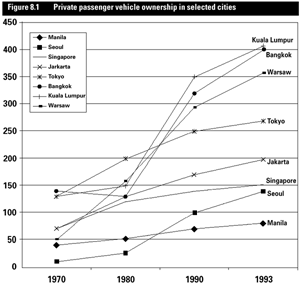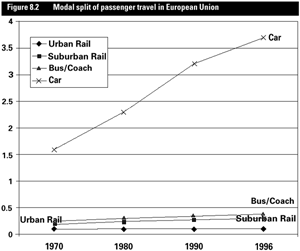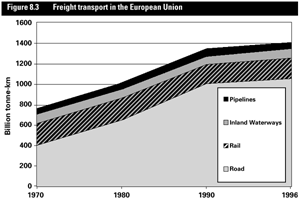
 |
| Figure 8.1: Private passenger vehicle ownership in selected cities |
In 1995, the transport sector accounted for 26.5% of total final energy consumption and 22% of carbon emissions from energy use (OECD, 1997; IPCC, 1996). Transport related carbon emissions including international aviation bunkers but excluding marine bunkers was the fastest growing between 1990 to 1995, with an annual rate of 2.4%. This growth occurred globally but not evenly. In 1995, Annex II countries accounted for 66% of the total, though emissions from developing countries are increasing their share. Similarly, per capita transport emissions are uneven, in 1995 it was 3.33 t CO2/capita in Annex II as compared to 0.29 t CO2/capita in non-Annex I countries (OECD, 1997).
Transport activities, and thus carbon emissions, because of the almost total dependence (about 97%) on petroleum-based fuels, have been growing dramatically since 1950. This is mainly due to decline in relative travel cost while at the same time incomes were rising. The dominant source of these carbon emissions is road travel. Vehicle ownership rose from 50 million in 1950 to 770 million in 1997, of which 78% were cars (Philpott, 1997). Vehicles on the road are estimated to rise by 50 million annually leading to a billion of them within 12-15 years time without direct intervention (UNEP, 1998). This growth varies among the different regions of the world. The industrialised regions with 21% of global population have 60% and 80% of commercial and passenger vehicles, while developing countries with 79% of the world's population have 40 and 20% respectively (Hilling, 1996). This disparity has a clear impact on their transport-related carbon emissions as shown in Table.8.1. Since 1970, phenomenal growth in private vehicle ownership is occurring worldwide as income rises; this is shown for cities of selected countries in Figure 8.1. This brings about a modal shift in passenger transport as can be seen for EU countries in Figure 8.2. Similarly, freight travel by road is growing faster than other modes with a significant shift from rail to road. These changes are shown in Figure 8.3 for European Union (EUROSTAT, 1997). Air travel has been growing faster than road travel. Between 1960 and 1990, air travel (passenger-km) grew by 9.5% annually and airfreight by a faster rate of 11.7% annually (ICAO, 1992). Though in recent times the overall annual growth has been about 5-6% and there has been reduction in energy intensity, this growth still surpasses economic growth. Controlling emissions from aviation is proving difficult.
| Table 8.1 Vehicle use and carbon emissions for world regions Source: United Nations Statistical Yearbook; IEA (1996) | |||||||
| WORLD REGION | GENERAL AND SELECTED TRANSPORT DATA FOR 1990 (% OF WORLD TOTAL) | DIRECT TRANSPORT CARBON EMISSIONS (MTC) | |||||
| AREA | POPULATION | COMM.VEHS. | PASS. VEHS. | 1971 | 1991 | 2010 | |
| North America | 16 | 5.2 | 40.1 | 35.3 | 1201 | 1588 | 2133 |
| Europe | 4 | 9.3 | 18.2 | 37.4 | 475 | 867 | 1180 |
| Former USSR | 16 | 5.2 | 0.2 | 4.8 | 215 | 429 | 736 |
| OECD Pacific | 7 | 2.5 | 1.9 | 2.0 | 150 | 300 | 460 |
| Latin America | 15 | 8.4 | 8.7 | 6.7 | 77 | 337 | 552 |
| Africa | 22 | 12.4 | 3.5 | 2.0 | 52 | 110 | 215 |
| Asia (ex Japan) | 20 | 57.0 | 27.4 | 11.8 | 136 | 522 | 1747 |
 |
| Figure 8.2: Modal split of passenger travel in European Union |
Emissions from rail transport have been declining mainly due to shifts in fuel use and modal changes in the overall activities in the transport sector. Fuel changes, mostly from coal to electricity and diesel, have had a significant impact on reducing carbon emissions. However, if emissions from the primary energy source of electricity are included, there may not be gains from electrified rail systems. Marine transport activities have been increasing steadily because they are dependent on world trade patterns. These activities declined in the late 1970s till the 1980s, but grew in the late 1980s due to the economic upturn in Asia, and then declined again as result of recession in that region. Emissions from shipping transport have followed this pattern, though not exactly because goods are now being moved in larger and more efficient marine vessels, especially dry bulk goods that form 60-70% of such movements (Michaelis, 1996).
Generally, growth in transport related emissions, especially from motorisation, has resulted in serious local and global environmental problems. Emissions from petroleum fuels are carbon monoxide (CO), carbon dioxide (CO2), hydrocarbons (HC), sulphur oxides (SOx), nitrogen oxides (NOx) and particulate matter (PM), and many secondary pollutants such as ozone and peroxyacetyl nitrates, and lead (Pb) from leaded fuels (Faiz et al., 1996). Many of these are hazardous to human health as irritants, allergens or carcinogens causing local problems especially for children. On a regional scale, SOx and NOx can cause air, water and land contamination; and globally, CO2 contributes to global warming (Walsh, 1997). In addition, growing road congestion in large cities worldwide is causing local pollution leading to high

|
| Figure 8.3: Freight transport in the European Union |
economic and social costs. The example of Santiago, Chile in which the children tend to have 25% higher incidence of coughing than those in other Chilean cities illustrates this (WRI et al., 1996). Stopping and starting of engines in congested traffic consumes more than three times more fuel than free-flowing traffic (Jourmad et al, 1990). Emissions from aircraft engines can be severe, especially CO2, which has the same effect as that at ground level, while the effects of other gases may be affected by height (Michaelis, 1996).
Transport related carbon emissions would grow significantly unless there is a major change in lifestyle and travel behaviour. It has been predicted that global transport energy use and, thus, GHG emissions (due to their linkage with petroleum fuels) will grow by 2.2-2.6% yearly from 1993 to 2010 (OECD, 1996). Also, since 1971 the transport share of total petroleum consumption has been rising steadily, and will grow from 55.6% in 1993 to 60% in 2010 if energy use continue to grow by 2.6% as it did between 1971 to 1993 (Wohlgemuth, 1997). GHG emissions from this growth will be substantial, and expected gains in vehicle fuel economy is estimated as 1 to 2% per annum based on historical trends and expected technical changes (Grubler et al., 1993; IEA, 1993, Greene and Duleep, 1993; DeCicco and Ross, 1993; Walsh, 1993). The major share of the growth is expected from private road transportation. Also, road transport of freight is expected to continue to dominate freight travel, as goods become lighter. The overall expected growth in transport related GHG emissions will be huge, and reducing it to meet the demands of the climate convention will require major changes because of the limits of technology changes. OECD estimated that projected technology improvements would only meet half of the effort required to achieve the demands of the UNFCCC (OECD, 1995, OECD 1997). Coping with expected transport growth is a challenge for the transport sector.
However, a number of policies and measures exist which if used while recognising local specificities could reduce transport related GHG emissions (IPCC, 1996). Similarly, good management practices are available which can moderate the growth in aviation fuel consumption and so reduce GHG emissions. These policies and measures could be transferred between and across regions if certain implementing barriers can be overcome. This chapter will concentrate on looking at the potential to transfer some of these options within and between countries. The chapter will largely be based on road transport due to its dominance in current and future GHG emissions in the transport sector.
|
Other reports in this collection |